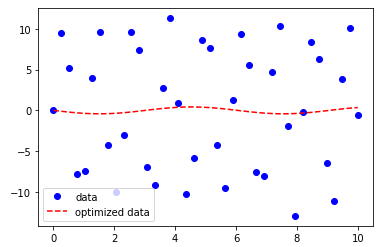SciPy Optimize
The optimize package provides various commonly used optimization algorithms. This module contains the following aspects:
- Global optimization routines(brute-force, anneal(), basinhopping())
- Unconstrained and constrained minimization of the multivariate scalar functions(minimize()) using various algorithms (BFGS, Nelders-Mead simplex, Newton Conjugate Gradient, COBLYA).
- Least-squares minimization algorithms(leastsq() and curve fit())
- Scalar univariate function minimizers (minimizer_scalar() and root finders newton())
Nelder- Mead Simplex Algorithm
The Nelder- Mead Simplex algorithm provides minimize() function which is used for minimization of scalar function of one or more variables.
Output:
final_simplex: (array([[ 1. , -1.27109375], [ 1. , -1.27118835], [ 1. , -1.27113762]]), array([0., 0., 0.])) fun: 0.0 message: 'Optimization terminated successfully.' nfev: 147 nit: 69 status: 0 success: True x: array([ 1. , -1.27109375])
Least Square Minimization
It is used to solve the nonlinear least-square problems with bound on the variables. Given the residuals (difference between observed and predicted value of data) f(x) (an n-dimension real function of n real variables) and the loss function rho(s) (a scalar function), least_square finds a local minimum of the cost function f(x): Let’s consider the following example:
Output:
active_mask: array([0., 0.]) cost: 0.0 fun: array([0., 0.]) grad: array([0., 0.]) jac: array([[-30.00000045, 10. ], [ -1. , 0. ]]) message: '`gtol` termination condition is satisfied.' nfev: 4 njev: 4 optimality: 0.0 status: 1 success: True x: array([1., 1.])
Root Finding
- Scalar functions
There are four different root-finding algorithms for a single value equation. Each algorithm needs the endpoints of an interval in which a root is expected (because the function changes signs).
- Sets of Equations
The root() function is used to find the root of the nonlinear equation. There are various methods such as hybr (the default) and the Levenberg-Marquardt method from the MINPACK.
Let’s consider the below equation
x2 + 3cos(x)=0
Output:
fjac: array([[-1.]]) fun: array([2.22044605e-16]) message: 'The solution converged.' nfev: 10 qtf: array([-1.19788401e-10]) r: array([-4.37742564]) status: 1 success: True x: array([-0.91485648])
Optimize Curve Fitting
Curve fitting is the technique of creating a curve. It is a mathematical function that has the best fit to a series of data points, possibly subject to constraints. The example is given below:
Output:
Sine funcion coefficients: [-0.42111847 1.03945217] Covariance of coefficients: [[3.03920718 0.05918002] [0.05918002 0.43566354]]

SciPy fsolve
The scipy.optimize library provides the fsolve() function, which is used to find the root of the function. It returns the roots of the equation defined by fun(x) = 0 given a starting estimate.
Consider the following example:
Output:
(array([1.]), array([82.17252895]))
